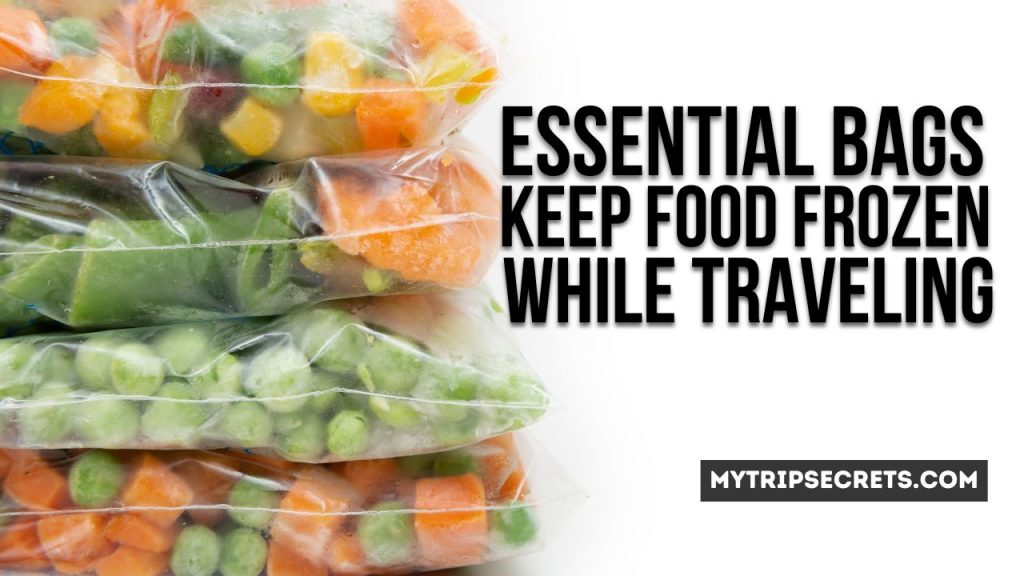Transporting frozen foods when traveling can be tricky. Whether road tripping or catching flights, you want those perishable goodies to remain fresh until reaching your destination. Nothing spoils a vacation quicker than thawed, inedible meals. This guide teaches foolproof methods to keep freezer items solidly frozen throughout any transportation scenario using practical tips and affordable products.
Contents
- 1 Why Proper Freezer Pack Transport Matters
- 2 How Long Different Frozen Goods Last During Travel
- 3 Proper Initial Freezing Steps
- 4 Essential Bags To Keep Food Frozen While Traveling
- 5 7 Ways To Keep Frozen Food Frozen While Travelling
- 6 Key Freeze Retention Methods During Transport
- 7 What To Do If Freezer Goods Start Thawing
- 8 Keeping Frozen Foods During Travel (FAQs)
- 8.1 What are signs my frozen foods thawed then got refrozen?
- 8.2 How do I find freezer bags or coolers guaranteed to stay sub-zero?
- 8.3 What should I do if there are no hotel or ship fridges available?
- 8.4 Can I reuse gel freezer packs after they thaw then re-solidify?
- 8.5 What food freezing tips prevent airport TSA inspection hassles?
- 9 Key Takeaways On Transporting Frozen Eats
Why Proper Freezer Pack Transport Matters
Freezing extra food is something many travelers bank on for saving money and enjoying delicious homemade cuisine even while away from home. However, failure to keep solidly frozen meats, prepared dishes, ice cream and more intact turns them into soggy, unsafe messes. Here’s why mastering frozen food transport is so vital:
- Avoids food waste: Letting items defrost too early ruins them, wasting money and resources.
- Prevents foodborne illness: Partially thawed then re-frozen goods pose safety risks from bacteria growth.
- Saves on travel expenses: Not replacing ruined food saves dining out and mini bar costs.
- Makes travel more enjoyable: Having favorite frozen meals, snacks and more enhances trips.
Per global research by the International Journal of Hospitality Management, over 33% of travelers lose frozen items to thawing, making safe transport methods essential knowledge.
How Long Different Frozen Goods Last During Travel
To effectively transport freezer items, you first must know general timeframe guidelines for how long they stay frozen using proper methods. Duration varies based on these packing factors:
- Insulation quality of your cooler/freezer bag
- Frozen item type (meals, meat, ice cream, etc)
- Quantity being transported
- Outside temperatures encountered
Here are the general duration ranges you can expect different common frozen item categories to remain solid during transport based on those criteria:
| Frozen Item Type | Usual Frozen Range During Travel |
|---|---|
| Precooked meals/casseroles | 1-5 days |
| Raw meat | 2-7 days |
| Fruits/veggies | 3-6 days |
| Baked goods/dough | 1-4 days |
| Ice cream | 1-2 days |
| Breaded/sauced meats | 1-4 days |
** Note: Times given are for high quality insulation methods described later in proper cold prevention steps. Duration ranges account for extreme weather fluctuations.
As you can see, frozen goods last longest when already cooked or plain. Moisture dense casseroles and ice cream thaw quicker. Now let’s explore optimal freezing and transportation processes to lock in that cold!
Proper Initial Freezing Steps
The first key in keeping foods frozen during transport is freezing them correctly beforehand using these best practices:
- Flash freeze thin items first – Spread items like burgers in a single layer on sheet pans and freeze for 1-2 hours before stacking together in bags. This prevents large ice crystals from forming.
- Use moisture barrier freezer bags – Press all excess air out of bags before sealing to reduce ice crystal formation damage. Choose plastic over zipper bags.
- Portion items for single meal usage – Freezing items in serving sizes means only thawing what you immediately need later, keeping the rest solid.
- Label everything clearly – Mark contents, quantity, date frozen and any reheating instructions so foods are identifiable frozen.
Properly flash freezing then sealing foods limits freeze burns and damage leading to quicker thawing. Portioning also helps gauge frozen state later.
Essential Bags To Keep Food Frozen While Traveling

Now that your food is expertly frozen, it’s time to pack it for transportation while retaining maximum cold. Having the right gear makes that possible even for weeklong durations. Here are the must-have solutions:
1. High Quality Coolers
Hard-sided rotomolded coolers like Yeti and RTIC brands keep extremes of cold or heat out thanks to 2-3 inches of insulation. Bonus features like freezer-grade gaskets on the lids create tighter seals. Choose carry sizes under 50 quarts for easier lifting. Pack with ice first, then items.
2. Insulated Freezer Bags/Cases
For easier packing minus bulky coolers, insulated soft cases keep freezer items cold nearly as well. Highly rated brands like PackIt Freezable bags and IceMule cases have walls lined with gel cores or proprietary freezing gels you pre-chill overnight then load with foods. Their flat, lightweight designs maximize space too.
3. Dry Ice
When needing items kept frozen for trips over 3 days without power sources, dry ice is the solution. At -109°F it keeps foods colder longer than regular ice. Just be sure to handle the pellets with heavy gloves and use insulating cardboard to separate them from direct food contact when packing your rig.
4. Digital Freeze Point Thermometers
These compact alarm thermometers flash and beep when interiors reach set temperature thresholds. Placing them right in with goods alerts you to any thawing before it’s too late to address. They take the guesswork out of monitoring freezer load states even in hard-to-check areas.
7 Ways To Keep Frozen Food Frozen While Travelling
With gear ready, correctly loading and securing your precious frozen cargo is next. Follow these professional packing methods:
- Pre-chill rig interiors first – coolers, gel packs, hard bottles, etc should be as cold as possible before adding foods.
- Pack densest items on bottom – Place brick-like frozen meal trays and ice packs beneath lighter ice cream tubs or breads.
- Cradle foods to prevent shifting – Immobilizing goods helps them maintain maximum surface contact with cold sources.
- Fill air gaps with newspaper – Wadded paper curbs temperature fluctuations from empty spaces.
- Only open when absolutely necessary – Limiting air entry means less ambient warmth gets in.
- Make a cold buffer top layer – Top off freezer loads with a “lid” of bottles/ice packs to retain cold air when you do open it up.
- Keep bags moisture-free – Condensation invites ice crystals, so wipe out interiors routinely to keep arid.
With everything expertly immobilized at sub-zero temperatures, now it’s time to implement other frozen food transport safety steps.
Key Freeze Retention Methods During Transport
Alright, your perfectly loaded freezer luggage is ready to roll out. But a few vital cold retention safeguards still apply once en route:
1. Shield Gear from Direct Sun
Never let cooler/freezers sit baking in hot sun while traveling. The radiant ambient heat surge thaws goods alarmingly fast. If you can’t keep them climate controlled, rig shade covers to curb heat gain. Reflective windshield screen fabric works great.
2. Utilize Freezer Pack Rotation
Have extra gel packs, chilled bottles and ice on hand to swap into your frigid load periodically. The newly introduced ultra-cold items buy frozen goods many extra hours of safe temps when original buffers melt down.
3. Insist on Air Conditioning!
In cars, blast that A/C directly on coolers to aid insulation in extreme heat. For hotel stays, keep freezer loads in bathrooms where plumbing makes ambient temps cooler. Never let them sit unchecked in hot parked cars.
4. Seek Out Cold Stowage
On cruise ships, many guest services teams will store and re-freeze your freezer bags if asked. For air travel, check insulated cooler bags with frozen items as luggage, avoiding high-altitude cargo areas prone to greater cold loss.
What To Do If Freezer Goods Start Thawing
Even with rigorous packing methods, poorly insulated loads or extreme heat sometimes outmatches gear capabilities. If you open up your frozen stash and find items soft or soggy, follow emergency steps below based on thaw levels:
Foods Still Cold & Firm To The Touch
- Quickly introduce cold replacement gel packs/ice/bottled drinks layered around goods.
- Wrap the partially thawed foods together in a central freezer bundle isolated from warmer outer items.
- Use an insulated bag within your main luggage or nest it into an air conditioned space.
- Check goods again in under 3 hours – if re-solidified with no ice crystallization, they can likely be safely refrozen upon arrival without wasting.
Foods Soft, Wet Or Turning Mushy
- Isolate questionable goods in plastic bags so they don’t cross-contaminate others with bacteria via moisture.
- Safely discard anything slimy, as this indicates dangerous microbial growth.
- Upon arrival, inspect each item individually – anything hardened again might still be salvageable for cooking.
- For damp items not yet fully liquefied, using them immediately in recipes requiring thawed preparation may be possible. But never re-freeze at this stage.
Keeping Frozen Foods During Travel (FAQs)
Have additional questions on retaining maximum frozen food freshness when transporting for trips? Here are helpful answers to some commonly asked queries:
What are signs my frozen foods thawed then got refrozen?
Big indicators are large ice crystals inside packaging, hardened dry sections, or unusual textures. Thaw/refreeze cycles create freezer burn damage. Inspect goods closely.
How do I find freezer bags or coolers guaranteed to stay sub-zero?
Seeking bags/coolers specifically marketed as “freezer grade” ensures they maintain those ultra-low temps. High quality rotomolded coolers plus PackIt and IceMule freezer travel cases are prime options to consider.
What should I do if there are no hotel or ship fridges available?
Exploring cooler rental companies, researching local 24-hour freezer storage units to purchase short term access, or asking to store items in airport restaurant freezers can sometimes provide solutions when lodging has no cold storage options on hand. Getting creative is key.
Can I reuse gel freezer packs after they thaw then re-solidify?
It’s typically fine to keep re-freezing gel packs if they haven’t burst or shown damage from expanding liquid. But their heat absorption rates slowly decline with each progressive thaw. So regularly cycle in fresh sets for ideal results.
What food freezing tips prevent airport TSA inspection hassles?
Packing items in clear zipper plastic bags instead of opaque ones, attaching item lists to bags, and transporting meats slightly frozen instead of rock solid are some tricks to speed visual inspections of frozen goods minimize messy thawing/repacking delays.
Key Takeaways On Transporting Frozen Eats
Hopefully these tips help you become a master at keeping precious frozen goods intact when traveling near or far. Allowing that expensive ice cream to melt en route is now a thing of the past! Remember these core advice nuggets:
- Invest in high quality coolers and insulating bags specifically rated to maintain freezing temps
- Practice ideal freezing protocols before packing items to maximize later transportation duration
- Only open rigs when absolutely necessary and use moisture barriers to limit frost and melt levels
- Monitor goods closely with digital thermometer alarms and frequently cycle fresh cold sources as buffers
- If thawing happens, quickly separate suspect items and address soggy ones immediately before bacteria spreads
Employing just a few of these pointers makes enjoying your favorite homemade frozen snacks on vacation totally possible. Bon voyage – your frozen lasagna has never been safer!

